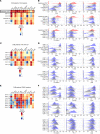Longitudinal liver sampling in patients with chronic hepatitis B starting antiviral therapy reveals hepatotoxic CD8+ T cells
- PMID: 36594467
- PMCID: PMC9797343
- DOI: 10.1172/JCI158903
Longitudinal liver sampling in patients with chronic hepatitis B starting antiviral therapy reveals hepatotoxic CD8+ T cells
Abstract
Accumulation of activated immune cells results in nonspecific hepatocyte killing in chronic hepatitis B (CHB), leading to fibrosis and cirrhosis. This study aims to understand the underlying mechanisms in humans and to define whether these are driven by widespread activation or a subpopulation of immune cells. We enrolled CHB patients with active liver damage to receive antiviral therapy and performed longitudinal liver sampling using fine-needle aspiration to investigate mechanisms of CHB pathogenesis in the human liver. Single-cell sequencing of total liver cells revealed a distinct liver-resident, polyclonal CD8+ T cell population that was enriched at baseline and displayed a highly activated immune signature during liver damage. Cytokine combinations, identified by in silico prediction of ligand-receptor interaction, induced the activated phenotype in healthy liver CD8+ T cells, resulting in nonspecific Fas ligand-mediated killing of target cells. These results define a CD8+ T cell population in the human liver that can drive pathogenesis and a key pathway involved in their function in CHB patients.
Keywords: Cellular immune response; Hepatitis; Immunology; Infectious disease; T cells.
Figures






Comment in
-
Liver-resident CD8+ T cells in viral hepatitis: not always good guys.J Clin Invest. 2023 Jan 3;133(1):e165033. doi: 10.1172/JCI165033. J Clin Invest. 2023. PMID: 36594469 Free PMC article.
References
Publication types
MeSH terms
Substances
LinkOut - more resources
Full Text Sources
Molecular Biology Databases
Research Materials
Miscellaneous

